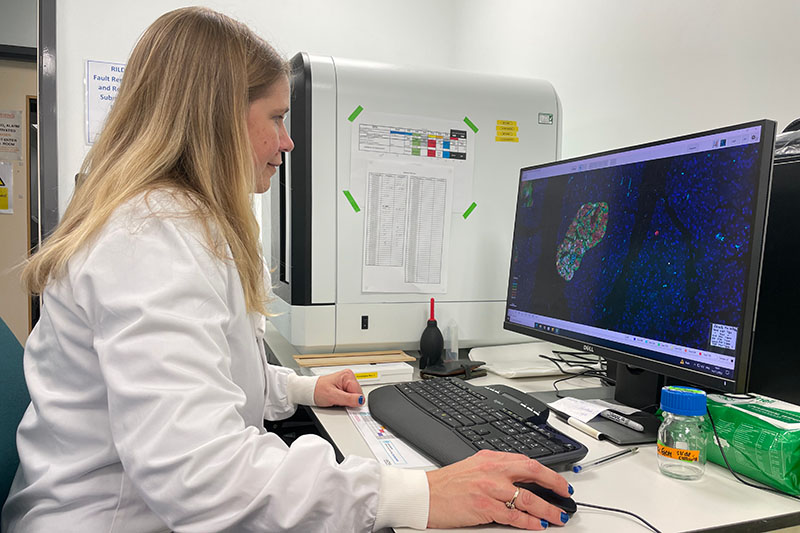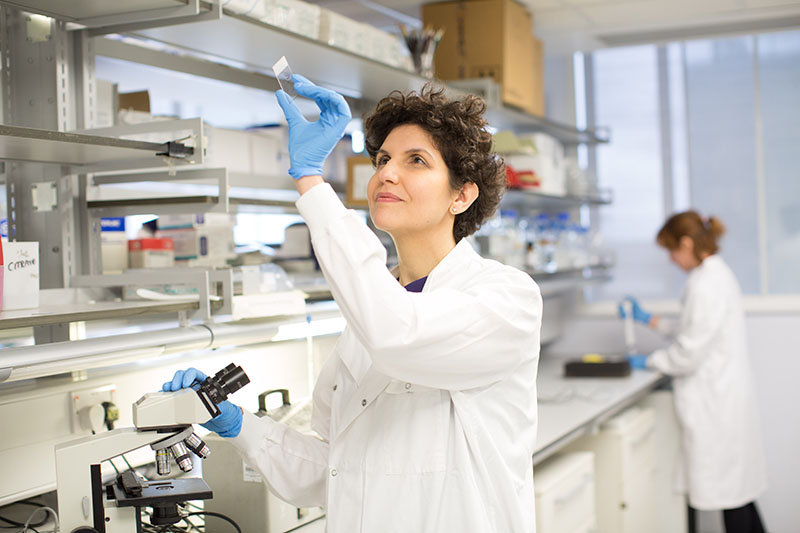
Treatments that target the immune system, known as immunotherapies, are emerging to tackle type 1 diabetes. In this blog, we explain what they are and their potential to make a life-changing difference for some people affected by type 1 diabetes. We also introduce two research projects that we’re funding in the UK that are looking at interesting immunotherapy approaches.
The trouble with treatment
Type 1 diabetes occurs when the immune system destroys the insulin-producing beta cells in the pancreas. For over a century, the treatment of type 1 diabetes has centred on replacing the insulin the person can no longer produce. But lifelong insulin treatment can only address the symptoms and keep complications of type 1 diabetes at bay. It doesn’t address the underlying root cause of the condition.
Teplizumab – what’s the big deal?
In November 2022, drug regulators in the US approved the use of a medicine called teplizumab. The news was greeted with huge excitement by experts, who described it as ‘monumental’ for type 1 diabetes. But what’s so special about it?
Teplizumab is the first approved drug to tackle the root of the problem. In a landmark clinical trial, a two-week course of teplizumab was found to slow the immune attack on beta cells and preserve insulin production for an average of three years in people with early-stage or presymptomatic type 1 diabetes. At this point type 1 hasn’t fully developed – the immune attack has begun but there are still enough beta cells to produce some insulin, and the symptoms of type 1 haven’t yet developed.
Delaying the development of type 1 diabetes means more years without insulin injections, constant blood sugar monitoring and carb counting. It can also reduce the risk of developing diabetes complications.
And this is just the start.
How do immunotherapies work?
Medicines that work by interacting with parts of the immune system – known as immunotherapies – have enormous promise for the prevention, treatment and maybe even cure of type 1 diabetes.
Our immune system works by identifying invaders in our bodies – such as bacteria and viruses – and ‘sounding the alarm’ to launch an attack. In this process, immune cells called killer T cells are taught to recognise and destroy the invader.
In people with type 1 diabetes, their immune system mistakenly attacks their own insulin-producing beta cells. Meanwhile, the peacemakers of the immune system – called regulatory T cells, or Tregs – are underpowered against the barrage. Teplizumab works by attaching to a protein on the surface of killer T cells. This stops the T cell from recognising beta cells, effectively hiding them from the immune system to evade attack.
Many more immunotherapies for type 1 diabetes are in the pipeline. Some work in a similar way to teplizumab, whiles others take a different approach, including:
- breaking the vicious cycle of inflammation in the pancreas that usually helps to sustain an immune attack
- boosting Tregs, the natural protectors that can deactivate killer T cells but are in short supply in type 1 diabetes
- neutralising the signals, called autoantibodies, that label beta cells as targets for attack.
The Type 1 Diabetes Grand Challenge is funding research into different immunotherapy strategies.
Interleukin-2 (IL-2): Boosting the Tregs
One Grand Challenge project is investigating a way to power up the peacekeeping force of Treg cells, to limit the immune attack on beta cells.
A protein called interleukin-2 (IL-2) is an important nutrient for Tregs and has been tested in clinical trials in people with type 1 diabetes before. The results have been promising but inconsistent..
However, Dr James Pearson has a theory that may explain why the results vary. His team have shown in mice that numbers of Tregs rise and fall in a daily pattern. And he thinks that synching IL-2 treatment with the natural Treg cycle could be crucial for success.
Dr Pearson said: “We’ve seen that there’s a time in mice, in the evening, when the number of Treg cells is at its lowest point in the 24-hour cycle. We think that might be the best time to give IL-2 therapy, because you’re then boosting them back up to a higher level to try to limit activation of the damaging killer T cells.”
They’re testing this theory in blood samples taken in the morning and the evening from volunteers with type 1 diabetes.
IL-2 is already known to be a safe treatment in children and adults. So, if the results from Dr Pearson’s study show a clear potential benefit to timed therapy, then a trial in people with type 1 diabetes could take place.
Abatacept and IL-2 – more than the sum of their parts?
Dr Danijela Tatovic’s Grand Challenge project is also exploring IL-2’s potential, in combination with another immunotherapy called abatacept.
Abatacept is currently used to treat rheumatoid arthritis, another autoimmune condition. It’s been trialled in people with type 1 diabetes where it’s been shown to be able to stop killer T cells attacking beta cells. However, it also weakens the helpful Tregs, which limits its usefulness.
Dr Tatovic is running a small clinical trial in people with type 1. One group will receive abatacept and another group will receive abatacept in combination with IL-2 at different doses and timings. After two months, the research team will see how the different types of immune cells are responding in each group.
Once they’ve established the best combinations of the two drugs, the team can design a larger trial to find out whether the therapy can protect beta cells from destruction and prevent or slow the progression of type 1 diabetes.
Getting closer to a cure
The discovery of insulin in 1921 has enabled countless people to survive and thrive with type 1 diabetes. The approval of teplizumab in the US one hundred years later represents the start of a new era of medicine for people living with and at risk of type 1 diabetes. Immunotherapies hold incredible potential for preventing, slowing down and stopping the destruction of beta cells by the immune system.
The Type 1 Diabetes Grand Challenge is also funding research to accelerate progress towards treatments that replace or regenerate the beta cells destroyed by the immune system. And – by combining immunotherapy with promising beta cell therapies – there’s a growing chance of a cure for people who may have never imagined it was possible.



